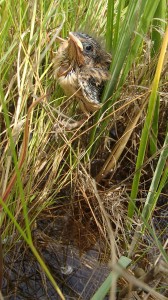Since 2002, members of our group have been studying the ecology and conservation of birds in tidal marshes. Initially, the focus was on saltmarsh sparrows at study sites along the Connecticut coast of Long Island Sound. Over time the scope has grown and we now work on a variety of species in marshes all along the US Atlantic Coast and on other aspects of marsh ecology and conservation through collaborations that range from the social sciences to biogeochemistry. Most of our work on this topic is conducted through one of two large collaborations: Our saltmarsh bird work is embedded within the Saltmarsh Habitat and Avian Research Program (SHARP), which involves researchers at several institutions. Our work on the broader ecology of Long Island Sound marshes is conducted in collaboration with the UConn lab groups run by Beth Lawrence and Ashley Helton, and researchers at the Connecticut Agricultural Experiment Station, the Connecticut Department of Energy and Environmental Protection, the Maritime Aquarium, and the Connecticut Natural Estuarine Research Reserve.
The conservation of tidal marsh birds.  This work has two parts. First, there is a large survey component designed to describe and understand the distribution and abundance of tidal marsh dependent birds in salt marshes from Virginia to Maine. Across this region, we are collecting data on birds and their habitat at thousands of point locations. An initial study in 2011-12 set out to estimate populations size for saltmarsh specialist birds, and to compare abundance to historical data to measure population change. In 2021-22, we repeated this survey to assess whether the trends we previously described have changed. In the intervening decade we collected similar data at many sites, especially those linked to marsh management designed to improve coastal resilience, to assess the efficacy of different management actions.
This work has two parts. First, there is a large survey component designed to describe and understand the distribution and abundance of tidal marsh dependent birds in salt marshes from Virginia to Maine. Across this region, we are collecting data on birds and their habitat at thousands of point locations. An initial study in 2011-12 set out to estimate populations size for saltmarsh specialist birds, and to compare abundance to historical data to measure population change. In 2021-22, we repeated this survey to assess whether the trends we previously described have changed. In the intervening decade we collected similar data at many sites, especially those linked to marsh management designed to improve coastal resilience, to assess the efficacy of different management actions.
Second, we are studying the demography of tidal marsh birds at multiple sites between Virginia and Maine. Much of the work on this project is being conducted through the SHARP collaboration, with graduate students at 5 different institutions responsible for different pieces of the study. Our central focus is to better understand the breeding biology of these birds, identify causes of population decline, project future population conditions, and devise conservation strategies.
Funding for this work has come from the US Fish and Wildlife Service, National Science Foundation, and National Fish and Wildlife Foundation, with matching funds from many other partners.
Sentinels of climate change: Coastal indicators of wildlife and ecosystem change in Long Island Sound. This project combines the analysis of historical data with the collection of baseline information in order to assess how climate change is affecting habitats along the shore of Long Island Sound. Funding comes from the Long Island Sound Study through the Connecticut Department of Energy and Environmental Protection. Initial results here.
Resilience of the tidal marsh bird and plant communities to Hurricane Sandy and assessment of restoration efforts. This project builds on our earlier work as part of the SHARP collaboration and is designed to do two things. First, it will extend our NSF project (above) and lay the ground work for assessing the longer-term responses of tidal marshes to hurricanes and anthropogenic stressors. Second, it will enable us to track the consequences of restoration work that is planned in response to Hurricane Sandy. This work is funded by the US Fish and Wildlife Service.
Human dimensions of LIS ecosystems: an evidence-based socio-ecological model for education and management. This project aims to investigate two problems associated with human responses to sea-level rise and tidal marsh loss. First, we plan to investigate the willingness of coastal landowners to participate in different types of conservation actions that will facilitate marsh transgression into the uplands. Second, we will investigate the influence that educational information has on attitudes about coastal protection. This work was designed by Chris Field as part of his PhD, and also involves collaboration with Ashley Dayer. The project is funded by Connecticut Sea Grant.
Behavior and life history of tidal marsh birds. Although much of our work has an applied focus we are also studying the basic biology of the birds that use coastal marshes. Currently, we are especially focused on (i) understanding the links between different parts of the life cycle (breeding, moult, migration, and overwintering) of saltmarsh and seaside sparrows and (ii) in better understanding the factors that influence the unusual mating system of saltmarsh sparrows. These projects are currently led by Alyssa Borowske and Emma Shelly, respectively, as part of their PhDs and are funded by National Science Foundation Graduate Research Fellowships.
Photo credits: Saltmarsh sparrow nestling, forced to climb out of its nest (which is submerged) during a high tide. © Photo taken by Alyssa Borowske and can be used only after first obtaining her permission.